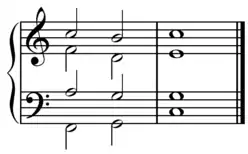Three-chord song
A three-chord song is a song whose music is built around three chords that are played in a certain sequence. A common type of three-chord song is the simple twelve-bar blues used in blues and rock and roll.

Typically, the three chords used are the chords on the tonic, subdominant, and dominant (scale degrees I, IV and V): in the key of C, these would be the C, F and G chords. Sometimes the V7 chord is used instead of V, for greater tension.
The I (tonic), IV (subdominant) and V (dominant) chords (primary triads) together encompass all seven tones of the tonic's major scale. These three chords are a simple means of covering many melodies without the use of passing notes.
The order of the chord progression may be varied; popular chord progression variations using the I, IV and V chords of a scale are:
- V – I – IV
- I – V – IV – V
- V – IV – I
Beside the I, IV and V chord progression, other widely used 3-chord progressions are:[1]
- I – vi – V
- I – ii – V
Quotes
Songwriter Harlan Howard once said "country music is three chords and the truth."[2]
Lou Reed said "One chord is fine. Two chords is pushing it. Three chords and you're into jazz."[3] Reed nevertheless wrote many songs with unique or complex chord progressions himself, such as the material on Berlin.
References
- "Chord progressions – TheGuitarLesson.com".
- "Harlan Howard Quotes". BrainyQuote. Retrieved 2017-01-26.
- "Rhino Records: The Rhino Musical Aptitude Test, 2001".